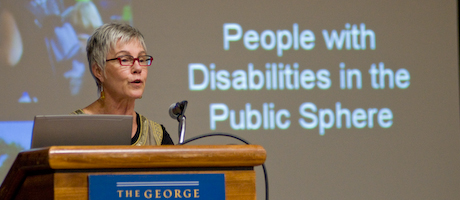By Menachem Wecker
Although Washingtonians often love to hate the Metro, they do not compare it with the cattle cars the Nazis used to transport the disabled to euthanasia clinics. Neither does Rosemarie Garland-Thomson, though she titled her Oct. 23 lecture “The Gas Chamber and the Metro: Space, Mobility and Disability.”
Dr. Garland-Thomson’s talk was the inaugural GW English Distinguished Lecture in Literary and Cultural Studies, which GW President Steven Knapp called “another significant milestone in the growth of humanities research and scholarship at The George Washington University” in his introduction.
In his introduction, José Muñoz, Wang Visiting Professor of Contemporary English Literature, called Dr. Garland-Thomson a “foundational presence in the field of disability studies.” The lecture was made possible by the support of the Wang Endowed Fund in English Literature and Literary Studies.
Throughout her talk, Dr. Garland-Thomson, a professor of women’s studies at Emory University, made clear she was studying literary rather than historical spaces.
“In comparing and contrasting the gas chamber and the Metro, I am not putting forth a progress narrative,” she told the audience of about 100 at the Marvin Center, “but rather I undertake a spatial analysis of the design, use and material aspects of these two historical circumstances to argue that the built environment reflects, produces and sustains both shared cultural understandings and the material reality of who is included in the human community, of who is worthy of citizenship and who is not.”
In other words, Dr. Garland-Thomson was not comparing the physical spaces where D.C.-area residents commute to work and where millions were murdered during World War II per se. Instead, she was contrasting the idea of the gas chamber with that of the metro.
Whereas the Nazis gas chambers formed a system in which hundreds of thousands of disabled people were selected for permanent exclusion (“unworthy citizenship”), the Metro was built upon a principle of universal access and selects disabled people (“worthy citizenship”) for democratic inclusion.
Dr. Garland-Thomson admits her juxtaposition is provocative but thinks it reveals an understudied contradiction in the way contemporary society responds to disabled people.
“On the one hand is the endeavor to integrate people with disabilities into the public world by creating an accessible, barrier free material environment,” she said. “On the other hand, is the medical mission to eliminate people with disabilities from the human community.”
The lecture never resolved the contradiction, but Dr. Garland-Thomson concluded that the Metro, in its accessibility and inclusiveness, is “literally the embodiment of democracy.”
The Metro might not be the only part of the Washington cityscape that is simultaneously shaping people and being shaped by people. In his introduction, Jeffrey Cohen, chair of GW’s English Department, said it is hard to forget that the University is a mere three blocks from the White House.
“Washington is a center of government. But it is also truly a global city and a capital of the arts,” he says. “The Kennedy Center is even nearer than the White House. The Library of Congress and Folger Shakespeare Library are adjacent to the Capitol. This new lecture series is our contribution to the vibrant humanities landscape of this city – and a public announcement of how strong humanities research is at GW. ”
Writing on the English Department blog, sophomore Tess Malone, says the lecture could further raise the department’s profile.
“After Dr. Garland-Thomson’s talk many of us will probably never view the Metro in the same way again,” she says. “This is the genius of her theory, she unearths theories that we all subconsciously were curious about, but never thought to ask about … If Garland-Thomson’s talk is an indicator for the future of the humanities at GW, there will be a very bright future.”


